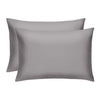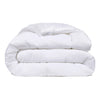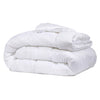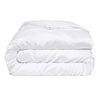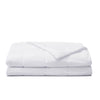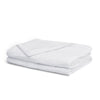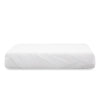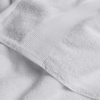The Daily Miracle
How To Wash Wool: A Step-by-Step Guide for Beginners
Published
February 11, 2025
Author
John Tsenekos

How To Wash Wool
Wool is a luxurious and versatile fabric, cherished for its warmth, softness, and natural resilience. However, to keep your wool garments looking and feeling their best, proper care is essential.
Washing wool correctly not only preserves its softness and vibrant appearance but also extends the life of your favorite pieces. Let's talk about the unique needs of wool and how to wash wool properly, so you can ensure that your woolen items remain a staple in your wardrobe for years to come.
Why Is Wool So High-Maintenance?
Wool is a natural fiber derived from the fleece of sheep, and even other animals like goats and alpacas. Wool fibers are naturally crimped, which gives them elasticity and the ability to trap air, providing excellent insulation and allowing them to weave into a variety of textures and patterns. This makes wool garments warm and comfortable, perfect for chilly weather. These unique properties make it a beloved choice for clothing and textiles, especially in colder climates.
However, these very properties also contribute to wool's high-maintenance reputation, as issues like pilling can occur with frequent wear and washing. Wool fibers are more delicate than synthetic fibers, which means they can easily become misshapen or damaged if not handled correctly. The natural scales on wool fibers can interlock during washing, leading to shrinkage and felting—a process where the fabric becomes dense and matted.
Additionally, wool is highly absorbent, capable of holding up to 30% of its weight in moisture without feeling wet. While this is great for wicking away sweat, it also means wool can be prone to stretching and losing its shape when wet.
To maintain wool's luxurious feel and appearance, you'll need to use gentle washing techniques and gentle detergents.
How to Wash Wool - Step by Step
Preparing Wool for Washing
Before you dive into washing your wool garments, a little preparation goes a long way in ensuring they come out looking fresh and fabulous. Here's how to get started:
Check the Care Label
The first step in preparing wool for washing is to check the care label on your garment. This small tag holds vital information about washing instructions and how to properly care for your wool item. It will indicate whether the garment is machine washable or if it requires hand washing. Some wool items may even need dry cleaning.
Gather the Necessary Supplies
-
Mild Detergent: Opt for a detergent that's either specifically designed for wool or is at least gentle on fabrics (detergent that's gentle on skin is a good indicator!).
-
Clean Towels: These will be useful for blotting excess water from your wool garment after washing.
-
A Basin or Sink: If you’re hand washing, ensure you have a clean basin or sink to work in.
-
A Drying Rack or Flat Surface: These are needed for drying your wool items without stretching them out of shape.
Pre-Treat Stains
Before washing, it's important to tackle any stains on your wool garment. Here’s how to do it effectively:
-
Blot, Don’t Rub: Gently blot the stain with a clean cloth to absorb as much of it as possible. Avoid rubbing, as this can push the stain deeper into the fibers.
-
Use a Mild Stain Remover: Apply a small amount of a wool-safe stain remover or stain-lifting detergent directly to the stain. Let it sit for a few minutes before washing.
-
Test First: Always test any stain remover on a small, inconspicuous area of the garment to ensure it doesn’t cause discoloration.
Washing Wool by Hand
Hand washing is a gentle and effective way to clean your wool garments, ensuring they maintain their shape and softness.
Fill a Basin with Water
Start by filling a clean basin or sink with lukewarm water. The ideal water temperature is around 85°F (30°C), which is warm enough to help dissolve dirt and detergent but cool enough to prevent shrinking or felting. Avoid using hot water, as it can cause wool fibers to contract and lose their shape.
Add Detergent
Next, add a small amount of gentle detergent to the water. We recommend Miracle Detergent Sheets, and in this case, you can use a quarter or half sheet depending on how much you're washing. This detergent is specially formulated to clean fabrics gently, free of harsh chemicals that could damage the fibers. Stir the water gently to distribute the detergent evenly.
Gently Wash the Wool
Now, it's time to hand wash your wool garment.
-
Submerge the Garment: Place your wool item in the basin, ensuring it is fully submerged in the soapy water.
-
Swish Gently: Using your hands, gently swish the garment around in the water. Avoid wringing or twisting, as this can stretch and damage the fibers.
-
Soak: Allow the garment to soak for about 10 to 15 minutes. This gives the detergent time to lift dirt and oils from the fibers.
-
Rinse Thoroughly: Drain the soapy water and refill the basin with clean, lukewarm water. Gently swish the garment to rinse out the detergent. You may need to repeat this step a few times until the water runs clear.
-
Press Out Excess Water: Once rinsed, carefully lift the garment out of the water and press it against the side of the basin to remove excess water. Avoid wringing or twisting.
Machine Washing Wool
While hand washing is often recommended for wool, many modern washing machines offer settings that can safely clean your wool garments.
Use the Right Cycle
When machine washing wool, you'll need to select the correct cycle to prevent damage. Look for a cycle specifically labeled for wool or delicates. These settings typically use a very gentle agitation and a lower spin speed to minimize stress on clothing and sensitive fabric fibers. If your machine has a "wool" setting, that's your best bet. Always use cold or lukewarm water to avoid shrinking or felting.
Choose the Right Detergent
Using the right detergent is key to maintaining the softness and integrity of your wool garments. You can use Miracle Detergent in your washer too—its gentle formula is designed for a powerful clean that's gentle on fabrics and skin, perfect for wool!
Drying Wool Properly
Proper drying is just as important as washing when it comes to wool care.
-
Air Drying: The safest method for drying wool is to lay the garment flat on a clean, dry towel. Gently reshape it to its original dimensions and allow it to air dry away from direct sunlight or heat sources. This method prevents stretching and maintains the garment's shape.
-
Avoid Machine Drying: While some wool items may be labeled as safe for tumble drying, it's generally best to avoid using a dryer. The heat and tumbling action can cause wool to shrink or lose its shape. If you must use a dryer, select a low-heat or no-heat setting and remove the garment while it's still slightly damp to finish drying flat.
Tips for Maintaining Wool
To ensure your wool garments remain as beautiful and cozy as the day you bought them, regular care and proper storage are essential. Here are some tips to help you maintain your wool items:
-
Brush and Air Out: Regularly brush your wool garments with a soft garment brush to remove surface dirt and lint. Air them out after wearing to allow any absorbed moisture to evaporate, which helps prevent odors and keeps the fabric fresh.
-
Spot Clean When Possible: Instead of washing your wool items after every wear, spot clean minor stains or spills with a damp cloth and a bit of mild detergent. This reduces the frequency of full washes, preserving the fabric's integrity.
-
Rotate Wear: Give your wool garments a break between wears. This allows the fibers to recover and maintain their shape, extending the life of the garment.
-
Use a Fabric Shaver: Over time, wool can develop pills—small balls of fiber that form on the surface. Use a fabric shaver to gently remove these pills and keep your garments looking smooth and new.
-
Clean Before Storing: Always clean your wool garments before storing them for an extended period. Dirt and oils can attract moths and other pests, which can damage the fabric.
-
Fold, Don’t Hang: To prevent stretching, fold wool garments rather than hanging them. If you must hang them, use padded hangers to support the shoulders and maintain the shape.
-
Store in a Cool, Dry Place: Keep wool garments in a cool, dry environment to prevent mold and mildew. Avoid storing them in plastic bags, as wool needs to breathe. Instead, use cotton garment bags or storage boxes.
-
Use Cedar or Lavender: To deter moths and other pests, place cedar blocks or sachets of dried lavender in your storage area. These natural repellents help protect your wool garments without the use of chemicals.
Conclusion
Washing wool effectively requires understanding its unique properties and using the right techniques to preserve its softness and shape. Whether you choose to hand wash or use a machine, selecting the appropriate water temperature, cycle, and detergent is key.
Miracle Detergent is an excellent choice for wool care, offering a gentle yet powerful clean that maintains the fabric's natural oils and softness. But Miracle Made Detergent isn't just for wool—it's a versatile solution for all your laundry needs.
With its deep cleaning power, hypoallergenic ingredients, and eco-friendly packaging, Miracle Detergent ensures your clothes are not only clean but also safe for your skin and the planet. Its ultra-concentrated formula means less clutter and more space, making laundry day a breeze.
Embrace the convenience and effectiveness of Miracle Detergent, and enjoy fresh, clean laundry every time!
Sources:


